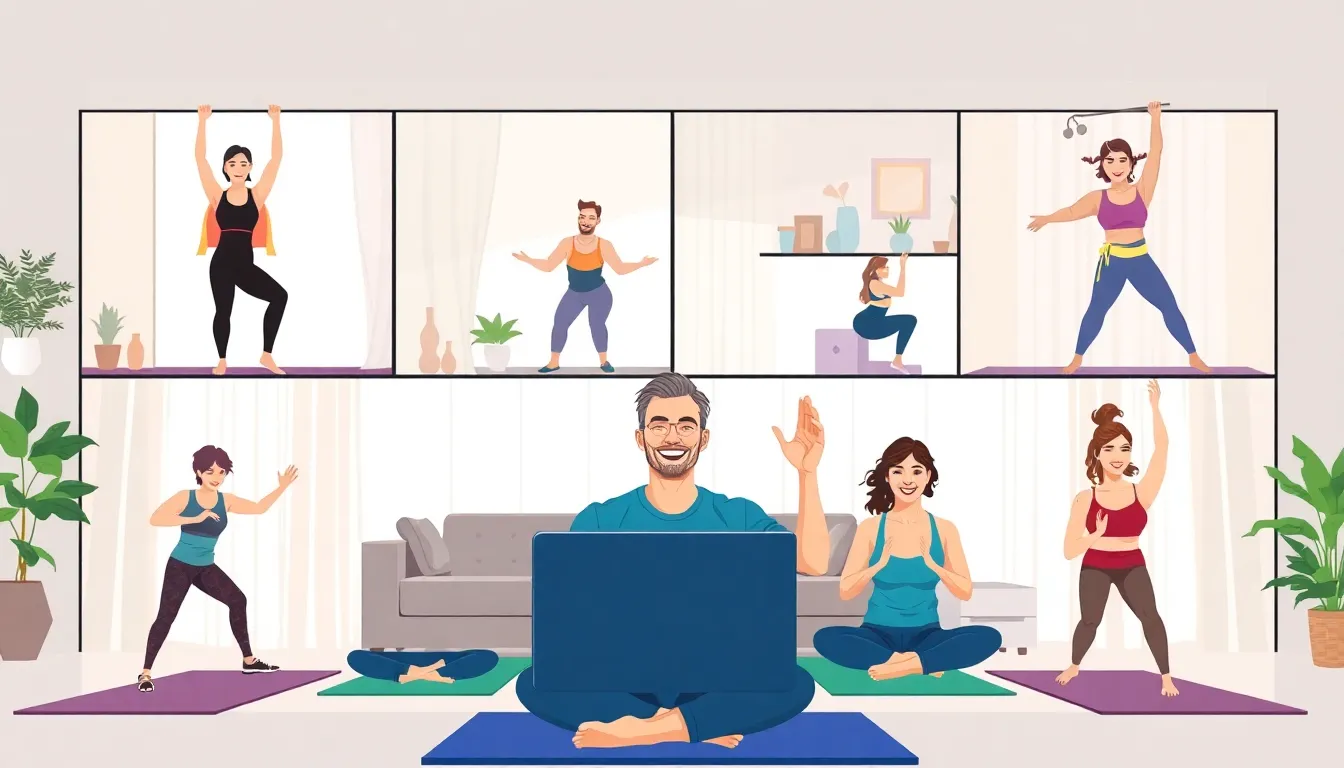Table of Contents
ToggleIn a world where sweatpants have become the unofficial uniform, virtual fitness classes are the new gym buddies we never knew we needed. Gone are the days of awkwardly trying to figure out how to use gym equipment while avoiding eye contact with that super-fit stranger. Now, one can break a sweat in the comfort of their living room, whether it’s with a high-energy Zumba class or a soothing yoga session.
Overview of Virtual Fitness Classes
Virtual fitness classes provide an effective solution for individuals seeking convenience in their workout routines. These online sessions allow participants to engage in various workouts from home, eliminating logistical hassles associated with gym visits.
Options include popular formats such as Zumba, yoga, strength training, and Pilates, catering to diverse fitness levels and preferences. Many platforms offer live classes, allowing for real-time interaction with instructors and motivation from fellow participants.
Recorded sessions also create flexibility, enabling individuals to access workouts that fit their schedules. With technology’s advancements, various apps and websites simplify finding and joining these classes.
Affordability remains a significant advantage; many programs offer competitive pricing or even free content. Additionally, social media platforms host live fitness events, broadening access to unique workout experiences.
Engagement is crucial in virtual settings, with many instructors incorporating elements to maintain motivation. Participants benefit from community aspects, with forums and social media groups fostering a sense of belonging.
Evidence suggests that individuals often stay consistent with fitness regimens due to the accessibility of virtual classes. They can seamlessly integrate workouts into daily routines without the intimidation factor present in gyms.
The rise of virtual fitness classes continues to reshape exercise habits, encouraging more people to adopt healthier lifestyles. With a variety of options available, users can find classes that align with their personal goals and interests.
Benefits of Virtual Fitness Classes

Virtual fitness classes offer multiple advantages that cater to individual preferences and lifestyles.
Flexibility and Convenience
Flexibility stands out as a key benefit of virtual fitness options. Individuals can easily fit workouts into their schedules since they aren’t bound by gym hours. A person may join a class in the early morning or late evening, adapting to personal routines. Convenience also comes into play; working out from home eliminates travel time and expenses. Many platforms provide access to recorded sessions, allowing participants to exercise whenever it suits them. Such adaptability enhances consistency in fitness regimens, promoting healthier habits.
Variety of Workout Options
A wide variety of workout options enhances the appeal of virtual fitness classes. Individuals can choose from different class types, including Zumba, yoga, strength training, and Pilates, ensuring that there’s something for everyone. This diverse selection allows participants to explore new workouts without the intimidation of a gym environment. Live classes foster community interaction, while recorded sessions let users revisit their favorites at any time. Engaging formats cater to various interests and fitness levels, making it easier for individuals to find activities they love and stay motivated.
Popular Platforms for Virtual Fitness Classes
Numerous platforms offer a variety of options for virtual fitness classes. The following sections provide insights into subscription-based services and free alternatives available to fitness enthusiasts.
Subscription-Based Services
Subscription-based platforms provide diverse options for virtual fitness classes. Notable providers include Peloton, Beachbody On Demand, and Les Mills. These services typically offer expansive class libraries that cover various workout types such as cycling, strength training, and yoga. Monthly subscriptions usually range from $10 to $40, depending on the platform. Participants gain access to live and recorded sessions, personal trainers, and structured programs. Engaging community features often enhance users’ workout experiences. Customers frequently report increased motivation and accountability through these services.
Free Options Available
Many free platforms cater to those seeking virtual fitness classes without a financial commitment. YouTube hosts a plethora of channels, including Fitness Blender and Yoga with Adriene, offering a wide range of workout types. Additionally, apps like Nike Training Club and FitOn provide free content alongside premium features. Virtual community initiatives, such as Facebook Live workouts, promote engagement and foster interaction among users. These resources allow individuals to try different fitness styles conveniently. Participants can access valuable workout routines while exploring new classes on their schedules without cost considerations.
Challenges of Virtual Fitness Classes
Virtual fitness classes offer numerous benefits, but they also present unique challenges. Addressing these issues is essential for maintaining a successful workout routine.
Motivation and Accountability
Motivation can dwindle without the gym environment’s social dynamic. Participants may struggle to stay committed when left to their own devices. Accountability often weakens, making it easier to skip workouts. In-person classes provide instant feedback and encouragement from instructors, which enriches the experience. Incorporating virtual communities can support motivation, but maintaining engagement requires effort. Interaction through chat features or social media can enhance accountability among users. Individuals who connect with workout buddies tend to remain committed to their routines. Regular check-ins or progress tracking can also strengthen the commitment to fitness goals.
Technical Issues
Technical issues frequently disrupt the flow of virtual fitness classes. Participants may face internet connectivity problems, resulting in interruptions during live sessions. Equipment compatibility can also present challenges, with some users lacking access to necessary devices. Poor audio or video quality can hinder the overall experience, causing frustration. Additionally, learning curves associated with new platforms can discourage beginners. Fortunately, clearer instructions and access to technical support can mitigate these difficulties. Users who are tech-savvy often find virtual classes more manageable, enhancing their workout experiences. Expanding access to troubleshooting resources can foster a smoother, more enjoyable fitness journey.
Virtual fitness classes have transformed the way people approach their workouts. They offer unmatched convenience and flexibility that traditional gyms often lack. With a wide variety of classes available online, individuals can choose workouts that suit their preferences and schedules.
While challenges like motivation and technical issues exist, the benefits of virtual fitness classes are significant. They allow for a personalized fitness experience that can lead to healthier lifestyles. As technology continues to improve and communities grow, the future of fitness is likely to remain digital, providing even more opportunities for engagement and support. Embracing this trend could be the key to achieving long-term fitness goals.




